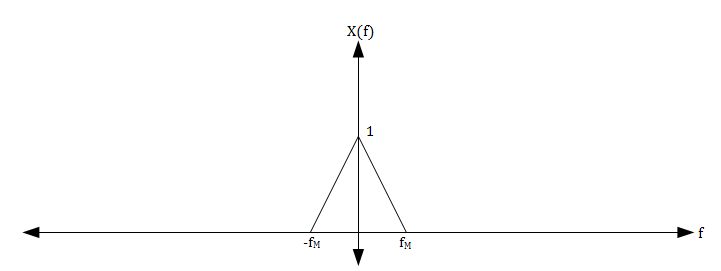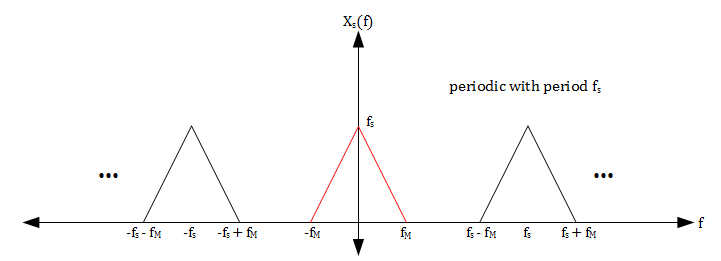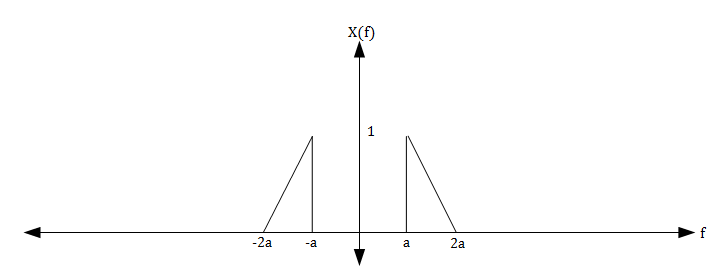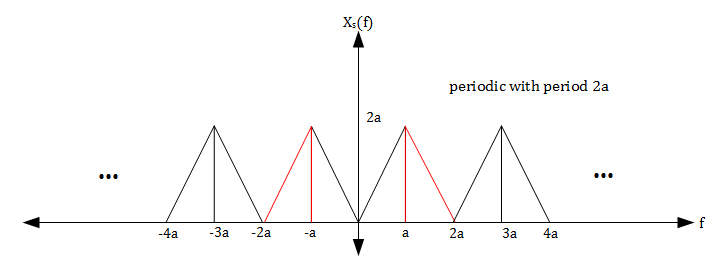| Line 1: | Line 1: | ||
| − | + | <br> | |
| − | + | <center><font size="4"></font> | |
| − | + | <font size="4">Downsampling </font> | |
| − | + | ||
| − | + | ||
| − | + | A [https://www.projectrhea.org/learning/slectures.php slecture] by [[ECE]] student Yerkebulan Yeshmukhanbetov | |
| − | + | ||
| − | + | ||
| − | + | Partly based on the [[2014 Fall ECE 438 Boutin|ECE438 Fall 2014 lecture]] material of [[User:Mboutin|Prof. Mireille Boutin]]. | |
| + | </center> | ||
| + | ---- | ||
| − | + | <font size="3"></font> | |
| − | </ | + | |
| − | + | <font size="3"> | |
| − | <font size = 3> | + | == Outline == |
| − | ==Outline== | + | |
| − | #Introduction | + | #Introduction |
| − | #Derivation | + | #Derivation |
| − | #Example | + | #Example |
| − | #Conclusion | + | #Conclusion |
#References | #References | ||
---- | ---- | ||
| − | ==Introduction== | + | == Introduction == |
| + | |||
| + | This slecture demonstrates downsampled signal in frequency domain. Also, it explains process of decimation and why it needs <br> | ||
| − | + | a low-pass filter. | |
| − | + | ||
---- | ---- | ||
| − | ==Derivation== | + | == Derivation == |
| − | Let | + | Let ''x<sub></sub>[n]'' be a digital-time signal shown below: <br> |
| − | + | ||
| − | + | ||
| − | |||
| − | |||
| − | + | GRAPH<br> | |
| − | + | ||
| − | + | then y[n] is produced by downsampling x [n] by factor D = 3. So, y [n] = x[Dn]. | |
| − | + | GRAPH<br> | |
| + | |||
| + | |||
| + | Nyquist Theorem: A signal <span class="texhtml">''x''(''t'')</span> that has the property <span class="texhtml">''X''(''f'') = 0</span> for <math> |f| \ge f_M </math> can be perfectly reconstructed from its sampling <span class="texhtml">''x''<sub>''s''</sub>(''t'')</span> if sampled at a rate <span class="texhtml">''f''<sub>''s''</sub> > 2''f''<sub>''M''</sub></span>. | ||
| + | |||
| + | To prove that perfect reconstruction is possible, we must find an expression for <span class="texhtml">''x''(''t'')</span> in terms of <span class="texhtml">''x''<sub>''s''</sub>(''t'')</span>. | ||
| + | |||
| + | Given that <math> \mathcal{F}(x(t)) = X(f) </math>, we can find <span class="texhtml">''X''<sub>''s''</sub>(''f'')</span> using the convolution property. | ||
<div style="margin-left: 3em;"> | <div style="margin-left: 3em;"> | ||
<math> | <math> | ||
| Line 58: | Line 58: | ||
&= f_s\sum_{k = -\infty}^\infty X(f-kf_s)\\ | &= f_s\sum_{k = -\infty}^\infty X(f-kf_s)\\ | ||
\end{align} | \end{align} | ||
| − | </math> | + | </math> |
| − | </div> | + | </div> |
| + | Without loss of generality, we can assume that the signal <span class="texhtml">''x''(''t'')</span> has the spectrum shown in the figure below. The shape of the graph of <span class="texhtml">''X''(''f'')</span> does not matter because the only important feature of <span class="texhtml">''X''(''f'')</span> is that <span class="texhtml">''X''(''f'') = 0</span> for <math> |f| \ge f_M </math>. | ||
| − | + | [[Image:X1.png]] | |
| − | + | We would like to determine what <span class="texhtml">''X''<sub>''s''</sub>(''f'')</span> looks like in order to find a way to reconstruct <span class="texhtml">''x''(''t'')</span>. | |
| − | + | Since we have sampled at a rate <span class="texhtml">''f''<sub>''s''</sub> > 2''f''<sub>''M''</sub></span>, the following inequalities hold: | |
| − | + | <math> f_s > 2f_M \iff f_s - f_M > f_M \iff -f_s + f_M < f_M </math>. | |
| − | < | + | Together, these inequalities, the graph of <span class="texhtml">''X''(''f'')</span>, and the expression for <span class="texhtml">''X''<sub>''s''</sub>(''f'')</span> in terms of <span class="texhtml">''X''(''f'')</span> imply that <span class="texhtml">''X''<sub>''s''</sub>(''f'')</span> will have the spectrum shown in the figure below. |
| − | + | [[Image:Xs1.png]] | |
| − | + | Notice that the spectrum of the ideal sampling of a signal is an amplitude scaled periodic repetition of the original spectrum. Since <span class="texhtml">''x''(''t'')</span> is bandlimited and we have sampled at a rate <span class="texhtml">''f''<sub>''s''</sub> > 2''f''<sub>''M''</sub></span>, the periodic repetitions of <span class="texhtml">''X''(''f'')</span> do not overlap. | |
| − | + | All the information needed to reconstruct <span class="texhtml">''X''(''f'')</span> can be found in the portion of <span class="texhtml">''X''<sub>''s''</sub>(''f'')</span> that corresponds to <span class="texhtml">''X''(''f'')</span> (shown in red). Therefore we can use a simple lowpass filter with gain <math> \tfrac{1}{f_s} </math> and cutoff frequency <math> \tfrac{f_s}{2} </math> to recover <span class="texhtml">''X''(''f'')</span> from <span class="texhtml">''X''<sub>''s''</sub>(''f'')</span>. | |
| − | + | <br> <math> | |
| − | + | ||
| − | + | ||
| − | <math | + | |
X(f) = X_s(f)\left\{ | X(f) = X_s(f)\left\{ | ||
\begin{array}{ll} | \begin{array}{ll} | ||
| Line 86: | Line 84: | ||
0, & \text{else} | 0, & \text{else} | ||
\end{array} | \end{array} | ||
| − | \right. </math> | + | \right. </math> |
| − | <math> \iff x(t) = x_s(t)*\text{sinc}(f_st) </math> | + | <math> \iff x(t) = x_s(t)*\text{sinc}(f_st) </math> |
| − | <math> \therefore </math> We can perfectly reconstruct < | + | <math> \therefore </math> We can perfectly reconstruct <span class="texhtml">''x''(''t'')</span> from <span class="texhtml">''x''<sub>''s''</sub>(''t'')</span>. |
---- | ---- | ||
| − | ==Example== | + | == Example == |
| − | Though the Nyquist theorem states that perfect reconstruction is possible if we satisfy the Nyquist condition < | + | Though the Nyquist theorem states that perfect reconstruction is possible if we satisfy the Nyquist condition <span class="texhtml">(''f''<sub>''s''</sub> > 2''f''<sub>''M''</sub>)</span>, it is important to note that this condition is not necessary. The following example demonstrates how perfect reconstruction is sometimes possible even when undersampling. |
| − | Let the signal < | + | Let the signal <span class="texhtml">''x''(''t'')</span> have a spectrum <span class="texhtml">''X''(''f'')</span> as seen in the figure below. |
| − | [[Image:X2.png]] | + | [[Image:X2.png]] |
| − | The Nyquist condition states that we should sample at a rate < | + | The Nyquist condition states that we should sample at a rate <span class="texhtml">''f''<sub>''s''</sub> > 2(2''a'') = 4''a''</span>. Instead, let us sample at <span class="texhtml">''f''<sub>''s''</sub> = 2''a''</span>. |
| − | As before, we have <math> x_s(t) = x(t)p_{\frac{1}{f_s}}(t) </math> and <math> X_s(f) = f_s\sum_{k = -\infty}^\infty X(f-kf_s) </math> | + | As before, we have <math> x_s(t) = x(t)p_{\frac{1}{f_s}}(t) </math> and <math> X_s(f) = f_s\sum_{k = -\infty}^\infty X(f-kf_s) </math> |
| − | <math> \implies X_s(f) = 2a\sum_{k = -\infty}^\infty X(f-2ka) </math>. | + | <math> \implies X_s(f) = 2a\sum_{k = -\infty}^\infty X(f-2ka) </math>. |
| − | Therefore, < | + | Therefore, <span class="texhtml">''X''<sub>''s''</sub>(''f'')</span> will have the spectrum shown in the figure below. |
| − | [[Image:Xs2.png]] | + | [[Image:Xs2.png]] |
| − | Notice that there is no aliasing in < | + | Notice that there is no aliasing in <span class="texhtml">''X''<sub>''s''</sub>(''f'')</span> even though <span class="texhtml">''f''<sub>''s''</sub> < 4''a''</span>. In addition, the portion of <span class="texhtml">''X''<sub>''s''</sub>(''f'')</span> that corresponds to <span class="texhtml">''X''(''f'')</span> (shown in red) can be recovered using a bandpass filter with gain <math> \tfrac{1}{2a} </math> and cutoff frequencies <span class="texhtml">''a'' and 2''a''</span>. |
---- | ---- | ||
| − | ==Conclusion== | + | == Conclusion == |
| − | To summarize, the Nyquist theorem states that any bandlimited signal can be perfectly reconstructed from its sampling if sampled at a rate greater than twice its bandwidth < | + | To summarize, the Nyquist theorem states that any bandlimited signal can be perfectly reconstructed from its sampling if sampled at a rate greater than twice its bandwidth <span class="texhtml">(''f''<sub>''s''</sub> > 2''f''<sub>''M''</sub>)</span>. However, the Nyquist condition is not necessary for perfect reconstruction as shown in the example above. |
| + | </font> | ||
| − | < | + | <font size="3"></font> |
---- | ---- | ||
| − | ==References== | + | == References == |
| − | [1] John G. Proakis, Dimitris G. Manolakis, "Digital Signal Processing with Principles, Algorithms, and Applications" 4th Edition,2006 | + | [1] John G. Proakis, Dimitris G. Manolakis, "Digital Signal Processing with Principles, Algorithms, and Applications" 4th Edition,2006 |
---- | ---- | ||
| + | |||
---- | ---- | ||
| + | |||
---- | ---- | ||
| − | ==[[ | + | == [[Nyquist Miguel Castellanos ECE438 slecture review|Questions and comments]] == |
| + | |||
| + | If you have any questions, comments, etc. please post them on [[Nyquist Miguel Castellanos ECE438 slecture review|this page]]. | ||
| − | |||
---- | ---- | ||
| − | [[ | + | |
| + | [[2014 Fall ECE 438 Boutin|Back to ECE438, Fall 2014]] | ||
| + | |||
| + | [[Category:Slecture]] [[Category:ECE438Fall2014Boutin]] [[Category:ECE]] [[Category:ECE438]] [[Category:Signal_processing]] | ||
Revision as of 11:58, 9 October 2014
Downsampling
A slecture by ECE student Yerkebulan Yeshmukhanbetov
Partly based on the ECE438 Fall 2014 lecture material of Prof. Mireille Boutin.
Contents
Outline
- Introduction
- Derivation
- Example
- Conclusion
- References
Introduction
This slecture demonstrates downsampled signal in frequency domain. Also, it explains process of decimation and why it needs
a low-pass filter.
Derivation
Let x[n] be a digital-time signal shown below:
GRAPH
then y[n] is produced by downsampling x [n] by factor D = 3. So, y [n] = x[Dn].
GRAPH
Nyquist Theorem: A signal x(t) that has the property X(f) = 0 for $ |f| \ge f_M $ can be perfectly reconstructed from its sampling xs(t) if sampled at a rate fs > 2fM.
To prove that perfect reconstruction is possible, we must find an expression for x(t) in terms of xs(t).
Given that $ \mathcal{F}(x(t)) = X(f) $, we can find Xs(f) using the convolution property.
$ \begin{align} X_s(f) &= X(f)*\mathcal{F}(p_{\frac{1}{f_s}})\\ &= X(f)*\mathcal{F}(\sum_{k = -\infty}^\infty \delta(t-\frac{k}{f_s}))\\ &= X(f)*f_s\sum_{k = -\infty}^\infty \delta(f-kf_s)\\ &= f_s\sum_{k = -\infty}^\infty X(f)*\delta(t-\frac{k}{f_s})\\ &= f_s\sum_{k = -\infty}^\infty X(f-kf_s)\\ \end{align} $
Without loss of generality, we can assume that the signal x(t) has the spectrum shown in the figure below. The shape of the graph of X(f) does not matter because the only important feature of X(f) is that X(f) = 0 for $ |f| \ge f_M $.
We would like to determine what Xs(f) looks like in order to find a way to reconstruct x(t).
Since we have sampled at a rate fs > 2fM, the following inequalities hold:
$ f_s > 2f_M \iff f_s - f_M > f_M \iff -f_s + f_M < f_M $.
Together, these inequalities, the graph of X(f), and the expression for Xs(f) in terms of X(f) imply that Xs(f) will have the spectrum shown in the figure below.
Notice that the spectrum of the ideal sampling of a signal is an amplitude scaled periodic repetition of the original spectrum. Since x(t) is bandlimited and we have sampled at a rate fs > 2fM, the periodic repetitions of X(f) do not overlap.
All the information needed to reconstruct X(f) can be found in the portion of Xs(f) that corresponds to X(f) (shown in red). Therefore we can use a simple lowpass filter with gain $ \tfrac{1}{f_s} $ and cutoff frequency $ \tfrac{f_s}{2} $ to recover X(f) from Xs(f).
$ X(f) = X_s(f)\left\{ \begin{array}{ll} \frac{1}{f_s}, & |f| \le \frac{f_s}{2}\\ 0, & \text{else} \end{array} \right. $
$ \iff x(t) = x_s(t)*\text{sinc}(f_st) $
$ \therefore $ We can perfectly reconstruct x(t) from xs(t).
Example
Though the Nyquist theorem states that perfect reconstruction is possible if we satisfy the Nyquist condition (fs > 2fM), it is important to note that this condition is not necessary. The following example demonstrates how perfect reconstruction is sometimes possible even when undersampling.
Let the signal x(t) have a spectrum X(f) as seen in the figure below.
The Nyquist condition states that we should sample at a rate fs > 2(2a) = 4a. Instead, let us sample at fs = 2a.
As before, we have $ x_s(t) = x(t)p_{\frac{1}{f_s}}(t) $ and $ X_s(f) = f_s\sum_{k = -\infty}^\infty X(f-kf_s) $
$ \implies X_s(f) = 2a\sum_{k = -\infty}^\infty X(f-2ka) $.
Therefore, Xs(f) will have the spectrum shown in the figure below.
Notice that there is no aliasing in Xs(f) even though fs < 4a. In addition, the portion of Xs(f) that corresponds to X(f) (shown in red) can be recovered using a bandpass filter with gain $ \tfrac{1}{2a} $ and cutoff frequencies a and 2a.
Conclusion
To summarize, the Nyquist theorem states that any bandlimited signal can be perfectly reconstructed from its sampling if sampled at a rate greater than twice its bandwidth (fs > 2fM). However, the Nyquist condition is not necessary for perfect reconstruction as shown in the example above.
References
[1] John G. Proakis, Dimitris G. Manolakis, "Digital Signal Processing with Principles, Algorithms, and Applications" 4th Edition,2006
Questions and comments
If you have any questions, comments, etc. please post them on this page.





